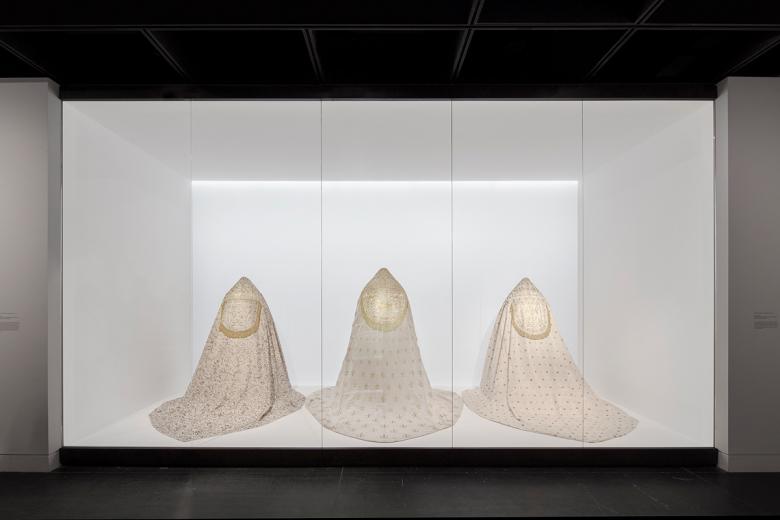Diller Scofidio + Renfro
Heavenly Bodies
Diller Scofidio + Renfro
9. 5月 2018
The Met Fifth Avenue: Anna Wintour Costume Center (Photo: Floto + Warner)
The Costume Institute’s spring 2018 exhibition features Papal robes and accessories from the Sistine Chapel sacristy and fashions from the early twentieth century to the present, shown in The Met's Byzantine and medieval galleries and at The Met Cloisters. DS+R’s approach to this project examines the notion of "Catholic space" to enable a dialogue between Fashion and medieval Christian art, the exhibit’s inceptive curatorial gesture.
Project: Heavenly Bodies: Fashion and the Catholic Imagination, 2018
Location: The Met Fifth Avenue andThe Met Cloisters, NewYork
Client: The Costume Institute,The Metropolitan Museum of Art
Architect: Diller Scofidio + Renfro
Partner in Charge: Elizabeth Diller
Project Lead: Kumar Atre
Project Team: Ricardo Scofidio, Matthew Johnson, Anthony Saby, Alex Knezo, Swarnabh Ghosh, Jack Solomon
Lighting Design: Tillotson Design Associates
Graphic Design: The Met’s Design Department
Structural Engineering: Laufs Engineering Design
Fabrication: New Project
Exhibition Area: 60,000 sf
The Met Fifth Avenue: Medieval Sculpture Hall (Photo: Floto + Warner)
Catholic space is an intricate mise-en-scene. The Catholic imagination invoked by the show’s title suggests a constellation of images, a world of immanence in which the spiritual is accessible via the sensual. Church liturgy is an immersive interweaving of diverse art forms. Scripture, music, architecture, art, and decorative arts work in concert to engender collectivity, ritual, and devotion. More than a stage or a container, Catholic space is the holistic integration of a multisensory aesthetic experience.
The Met Fifth Avenue: Anna Wintour Costume Center (Photo: Floto + Warner)
Fashion is a natural extension of this model, sculpting ineffable fantasies into a discourse on cultural inheritance — Catholicism included. Contemporary designers often draw on the same pool of timeless Christian imagery as the Byzantine and medieval artists represented in The Met’s collection, creating potential for powerful resonances between modern garments and historic artworks. To facilitate this exchange, DS+R conjures the integrative and immersive framework of Catholic space.
The Met Fifth Avenue: Anna Wintour Costume Center (Photo: Floto + Warner)
Visitors will discover the garments and accessories as a series of discrete interventions across 27 galleries spread over two locations. A custom display system stitches the many galleries together. The displays respond to the specificities of both the art they display as well as the diverse conditions of the gallery sites. They translate dimensional and material qualities into a family of objects (e.g. pedestal, platform, vitrine, etc.) with a coherent architectural language that lets them stand out from their context. Each display in the sequence draws the historic art and architecture into dialogue with the fashions to create a durational experience with an emphasis on rhythm, narrative, and atmosphere.
The Met Fifth Avenue: Byzantine Gallery (Photo: Floto + Warner)
The installation plays on the preeminence of light within Catholic space. Natural light is one of the most moving dimensions of medieval churches. It imparts a sense of time and a deep exteriority. Within the exhibition, the marching rhythm of the garments is periodically punctuated with projections of "supernatural daylight." As if by providence, key works are revealed within window-shaped frames of cool crisp light. Isolated from their neighbors, they are brought into a direct relationship with their architectural environment and the sky implied beyond. As an interruption of the codes of museum experience, this creates an affective bridge to another, perhaps more spiritual, world.
The Met Cloisters: Fuentidueña Chapel (Photo: Floto + Warner)
While the modern and contemporary fashion objects are enlivened by their proximity to their sources of reference (and inspiration), the papal robes and accessories from the Sistine Chapel sacristy are presented in an abstract setting, in display furnitures that respond to the qualities of each object. This visual "decontextualization" gives precedence to their magnificent physicality and otherworldly craftsmanship.
The Met Cloisters: Gothic Chapel (Photo: Floto + Warner)
The exhibition design strikes a balance between an experience which feels elevated, and one which allows for the requisite level of criticality within a broader material culture. On the one hand, religion is sacred and inviolate, but on the other, it has always engaged with art and design.The tension this exhibition explores is how that relationship, and the values it expresses, change over time.








